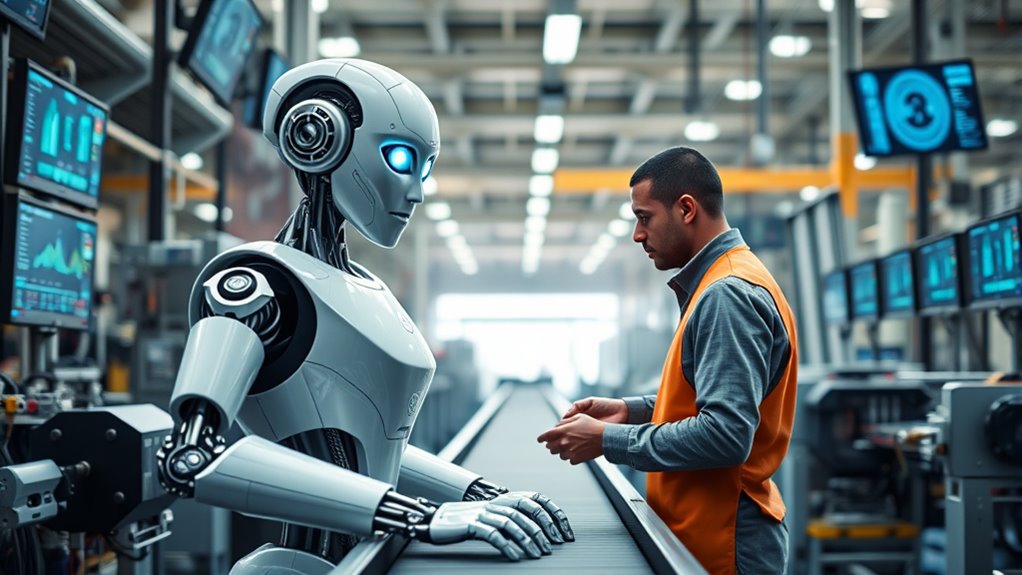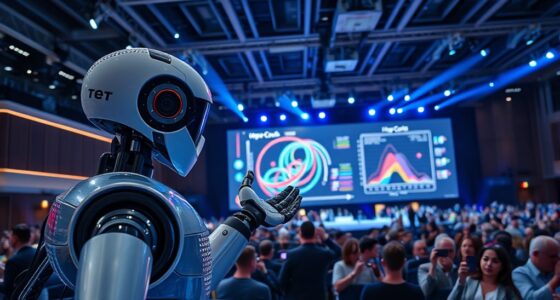Robots aren’t just stealing jobs; instead, they’re reshaping and redefining the way we work. While automation may displace some roles, it also creates millions of new opportunities, especially in sectors like healthcare, tech, and green energy. This shift requires you to develop new skills and adapt to evolving roles. If you keep exploring, you’ll discover how working alongside robots can open exciting career paths and help you stay competitive in a changing world.
Key Takeaways
- Automation is displacing some jobs but primarily redefines roles, emphasizing new skills like AI oversight and digital literacy.
- Nearly 75 million jobs may be eliminated by 2025, but AI is projected to generate around 133 million new roles globally.
- Sectors like healthcare, education, and green energy are experiencing growth, indicating role transformation rather than disappearance.
- The evolving job landscape highlights the importance of continuous learning and adaptation to stay relevant.
- Technological progress fosters innovation, creating opportunities for new careers instead of solely removing existing ones.
The Current Landscape of Job Displacement and Creation
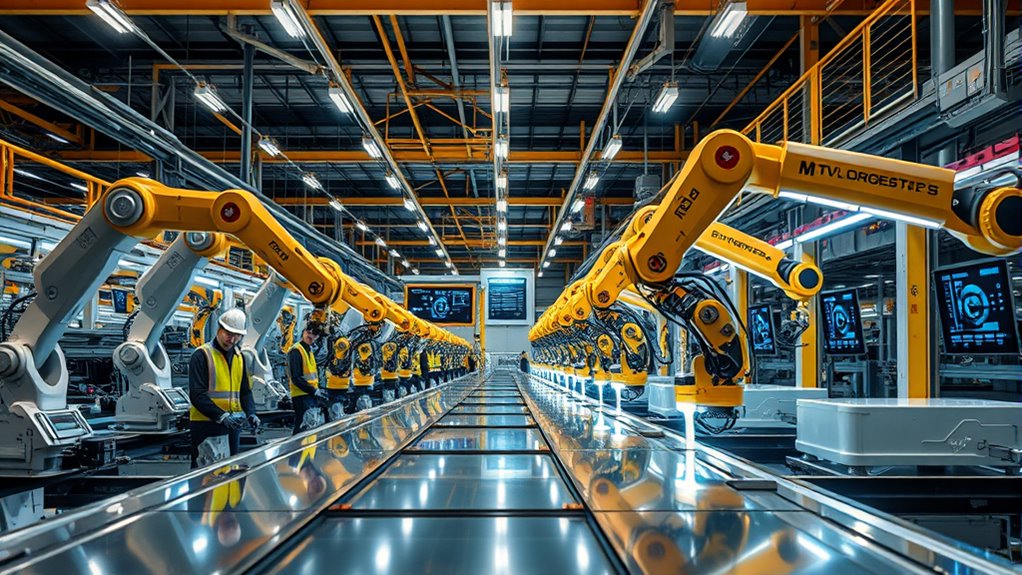
Despite technological advancements, the job market remains dynamic, with both displacement and creation happening simultaneously. In April 2025, 177,000 new jobs were added, keeping unemployment steady at 4.2%. By 2030, the market is expected to grow by 7%, driven by sectors like farming, delivery, and construction. At the same time, automation is set to displace about 8% of current jobs, mainly through redefining roles rather than eliminating them entirely. New opportunities will emerge, especially in green energy, healthcare, education, and technology, creating around 170 million new jobs. To thrive, you’ll need to develop resilience and adaptability, as skills like leadership, social influence, and tech expertise become increasingly valuable in this evolving landscape. Technological change is expected to be the most transformative driver shaping these trends, emphasizing the importance of continuous learning and skills development. Additionally, understanding how job roles are being redefined through automation can help workers better prepare for the future. Recognizing that automation often redefines tasks rather than replaces entire occupations can help individuals adapt more effectively. Moreover, cultivating emotional resilience can make transitioning into new roles smoother and less stressful. Furthermore, awareness of privacy and cookie policies can help users better understand how their online data is managed, ensuring informed choices about their digital footprint. Incorporating AI-powered analytics can also provide workers with insights to adapt their skills to emerging industry demands.
How Automation Is Transforming Industry Roles and Skills

Automation is rapidly reshaping industry roles and the skills required to perform them. You’ll find that many jobs now demand advanced technical and digital skills to stay relevant. For example, in energy, utilities, and mining, nearly half of jobs face high automation risk, pushing workers to learn new tech skills. In manufacturing, 60% of jobs are exposed to AI, shifting focus from manual tasks to robotics maintenance and AI oversight. Retail roles are transforming as 70% of jobs are automated, requiring skills in e-commerce and digital customer service. Managerial tasks are also evolving, with 69% becoming automatable by 2024, emphasizing strategic and interpersonal skills. To adapt, you’ll need to develop digital literacy, critical thinking, and multidisciplinary problem-solving abilities. Global robotics deployment has reached 2.5 million industrial robots worldwide, highlighting the accelerating pace of automation across industries. Additionally, the increasing integration of robotic technology into various sectors underscores the importance of acquiring new competencies to remain competitive in the evolving job landscape. The integration of natural materials and vintage decor is also influencing how industries approach workspace design, fostering a more human-centered environment that balances technology with comfort. Moreover, understanding Bitcoin IRA and other financial tools can help workers diversify their income streams and future-proof their financial stability amid technological change. Staying informed about technological advancements and automation trends can further prepare workers for upcoming industry shifts. Recognizing the importance of upskilling ensures professionals are ready for the new demands of automated workplaces.
The Economic and Social Impacts of Robotic Integration
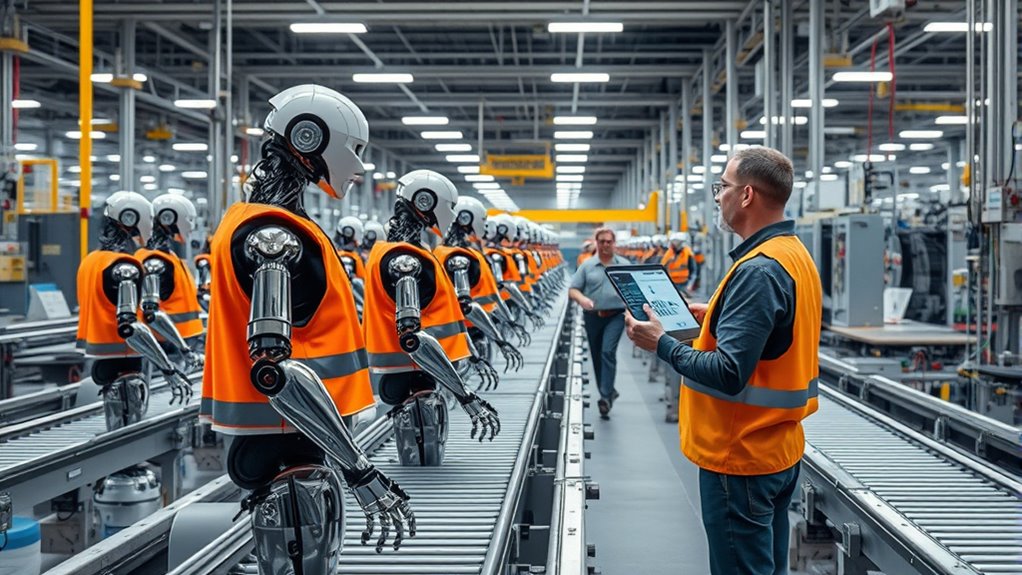
Robotic integration is transforming economies and societies by reshaping employment patterns and driving economic growth. While automation may displace millions of jobs—projected at 85 million globally by 2025—it also creates opportunities, with over 12 million new roles expected by 2025. Industries see productivity boosts of up to 30%, lowering costs and increasing profits, especially in manufacturing and e-commerce. Nations investing in robotics gain a competitive edge, fueling economic growth and market expansion. Furthermore, as the Law of Attraction suggests, positive perceptions of technological progress can foster innovation and adaptation among workers and industries alike. Additionally, the integration of AI technologies, such as natural language processing, enhances customer experience and streamlines business operations, further supporting economic transformation. Recognizing the importance of skilled workforce development is crucial for adapting to these rapid changes. Developing a growth mindset can help workers embrace new roles and opportunities created by automation. Emphasizing the importance of AI literacy can also empower workers to better understand and leverage new technologies in their careers.
Workforce Adaptation: Training and Education for a Changing Job Market
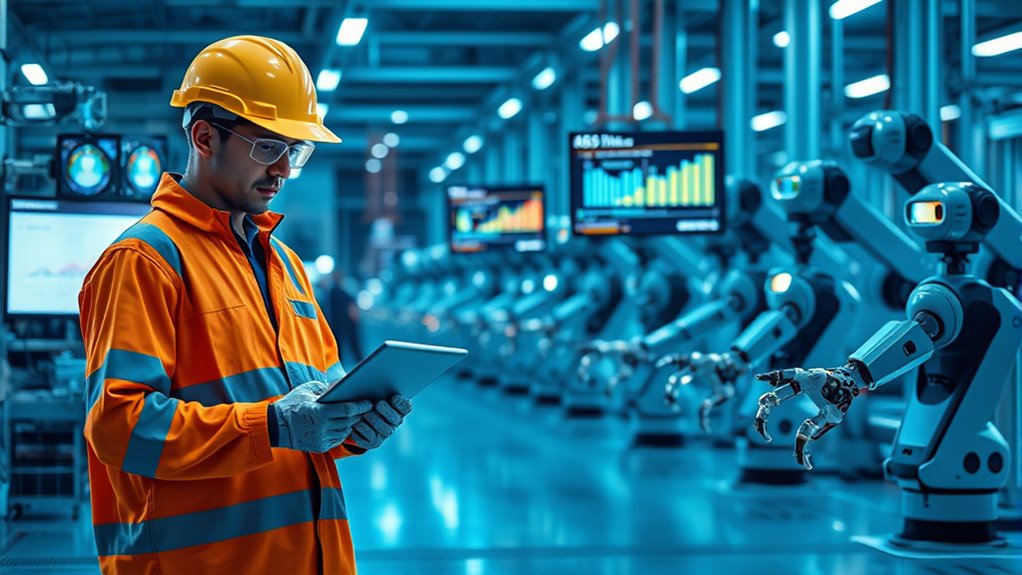
As the job market rapidly evolves due to technological advances, you must keep updating your skills to stay relevant. The skills you need are shifting, with about 39% becoming outdated between 2025 and 2030. To adapt, many employers plan to prioritize upskilling, with 85% investing in their workforce. They’re also hiring for new skills—70% intend to do so—and reducing roles with less relevant skills (40%). To succeed, focus on developing:
As the job market evolves, updating skills and embracing adaptability are essential for success.
- Resilience, flexibility, and agility alongside technical skills
- Leadership and social influence—human-centred skills in demand
- The ability to learn continuously, especially in gig economy roles. Incorporating home organization strategies can also improve your productivity and create a more efficient work environment. In addition, acquiring nutritional literacy can help you better understand how to maintain health amidst a changing work environment. Integrating AI literacy into your skill set is increasingly important as AI capabilities become essential across roles. Supporting your health and embracing diversity initiatives will also boost your adaptability. Understanding wall organization strategies can help you create a more efficient and inspiring workspace at home or in the office. Staying proactive in learning is key to steering this changing job landscape. Incorporating Hyundai Tuning techniques into your skill development can also inspire innovative problem-solving approaches in your career.
The Future Outlook: Evolving Jobs in the Age of AI and Robotics
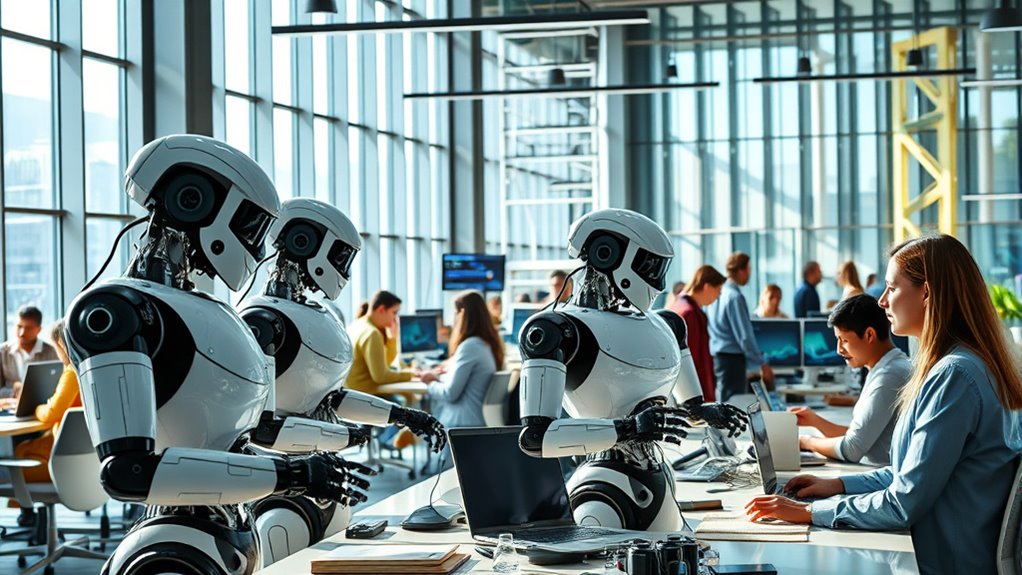
Technological advances like AI and robotics are reshaping the job landscape at an unprecedented pace. By 2030, robots and autonomous systems will displace around 5 million jobs, with AI expected to eliminate 75 million globally by 2025. Industries like energy, utilities, and mining face high automation risks, and overall, automation is forecasted to displace more jobs than it creates. However, AI also opens new opportunities, creating an estimated 133 million jobs worldwide by 2025, with a net gain of 58 million. These new roles demand skills in critical thinking, creativity, and problem-solving. The projected economic impact of AI is estimated at $15.7 trillion by 2030. Sectors like healthcare and education will see significant growth. As automation increases, workers will need to adapt, collaborating with AI to enhance productivity and redefine their roles in a transforming job market.
Frequently Asked Questions
How Can Workers Transition Into New Roles Created by Automation?
You can shift into new roles created by automation by embracing continuous learning and reskilling. Seek out employer-led training programs and online resources to develop digital, technical, and soft skills like problem-solving and communication. Collaborate with educational institutions and your employer to identify transferable skills. Stay adaptable, open to change, and focus on areas where human strengths, such as creativity and emotional intelligence, remain essential for future job success.
What Industries Are Most Resistant to Automation and Job Displacement?
Imagine you’re a nurse providing personalized patient care. You know that healthcare relies heavily on empathy, emotional intelligence, and complex judgment, making it resistant to automation. Many industries like healthcare, education, and social services require nuanced human interaction, trust, and ethical decision-making that robots can’t replicate. Because of these needs, they’re less likely to be fully automated, giving workers in these sectors a natural buffer against job displacement.
How Do Automation and AI Impact Wage Levels Across Sectors?
You see that automation and AI are putting downward pressure on wages across many sectors. White-collar jobs, especially those involving programming and writing, face wage compression as AI enables lower-skilled workers to do higher-quality work. In sectors heavily affected, wages tend to stagnate or decline, and your bargaining power diminishes. While some industries grow despite AI, overall, automation reshapes wages by increasing competition and reducing the demand for human labor.
What Policies Are Effective in Protecting Displaced Workers?
You want to know what policies protect displaced workers. While automation changes industries, effective strategies like expanding retraining programs, offering wage insurance, and providing income support help workers shift smoothly. Collaborate with businesses and educational institutions to align training with market needs. Subsidize education, incentivize employer retraining, and improve job placement services. These actions reduce hardship, support community stability, and guarantee workers stay resilient amid technological shifts.
Will AI Eventually Create More Jobs Than It Eliminates?
You might wonder if AI will ultimately generate more jobs than it takes away. Based on current trends, AI is expected to create around 97 million new roles by 2025, surpassing the jobs displaced. You’ll need to adapt by developing new skills for emerging roles, especially in tech and AI-related fields. While some jobs will be lost, the overall job market is likely to grow, offering new opportunities for those ready to evolve.
Conclusion
So, as you watch robots take on new tasks, it’s clear they’re not just stealing jobs—they’re reshaping them. Just like you might find your favorite old job evolving into something new, it’s all part of a bigger picture. Coincidentally, the skills you learn today could be what keeps you ahead tomorrow. Embrace the change, because in this tech-driven world, adapting might be the key to thriving—not just surviving.
